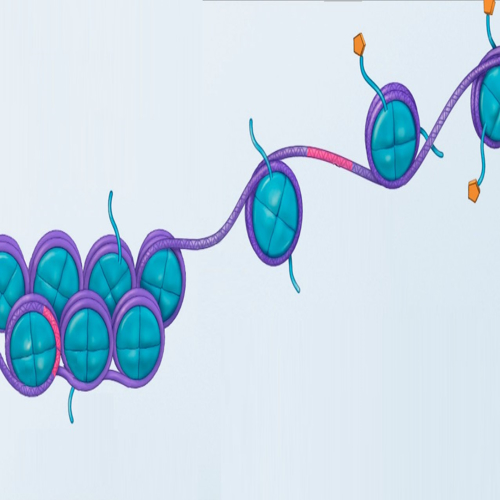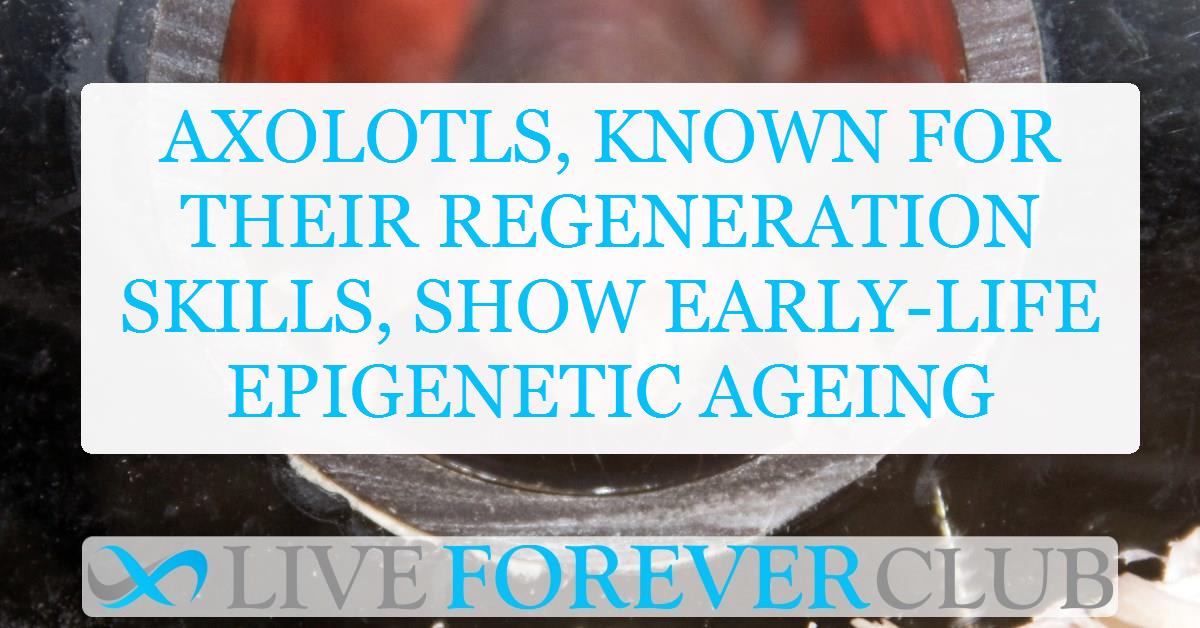For decades, scientists have been fascinated by the axolotl, a peculiar Mexican salamander known for its extraordinary ability to regenerate limbs, organs, and even parts of its brain and heart. This remarkable creature can recover from injuries that would be fatal or permanent for most other organisms. But that’s not all—the axolotl exhibits traits of negligible senescence, a phenomenon where organisms show little to no signs of ageing throughout their lifespan.
This unique combination of regeneration and slow ageing has made the axolotl a prime candidate for research on ageing, longevity, and regenerative medicine. Recently, scientists developed the first-ever axolotl epigenetic clocks—a tool used to track biological age based on DNA methylation patterns. Their findings offer significant insights into how axolotls defy ageing and might help inform future research on human longevity.
What is Negligible senescence?
Negligible senescence refers to the phenomenon where certain organisms do not show typical signs of ageing, such as a decline in reproductive capacity, increased mortality, or the gradual deterioration of physiological functions. While most species, including humans, experience the unavoidable effects of ageing, some species, like lobsters, turtles, and salamanders, seem to age so slowly that they appear almost ageless.
These animals defy the typical biological rules that govern ageing, often avoiding diseases associated with ageing, such as cancer or cardiovascular diseases. For scientists, these negligibly senescent species represent a biological puzzle: how do they maintain their vitality for such extended periods? Solving this puzzle could have profound implications for human ageing and longevity.
Axolotls as Models of Regeneration
Axolotls (Ambystoma mexicanum) are among the most impressive examples of regenerative capabilities in the animal kingdom. Unlike humans, who can only regenerate certain tissues like skin or liver to a limited extent, axolotls can regenerate entire limbs, parts of their spinal cord, heart, brain, and other organs. This ability to regenerate without scarring or ageing is a key reason they are widely studied in regenerative biology.
Axolotls belong to a group of amphibians known as urodeles, which have the most extensive regenerative abilities of any vertebrates. They can regenerate tissue at any point in their life, from juvenile to adult stages, which makes them an invaluable model organism for scientists interested in both regeneration and ageing.
Epigenetics and DNA Methylation
Before diving into the research on axolotl epigenetic clocks, it's important to understand a bit about epigenetics—the study of changes in gene expression that do not involve alterations to the underlying DNA sequence. These changes can occur through various mechanisms, one of which is DNA methylation, where methyl groups are added to the DNA molecule, typically at specific locations known as CpG sites.
DNA methylation is a key regulator of gene expression and plays a crucial role in cellular processes, including development, ageing, and disease progression. As organisms age, their DNA methylation patterns tend to change in predictable ways, which can serve as a molecular "clock" to estimate an organism’s biological age.
Epigenetic clocks are built by identifying specific DNA methylation patterns that correlate with ageing. These clocks have been developed for a variety of species, including humans, mice, and more recently, the axolotl. By studying these methylation patterns, scientists can gain insights into the biological processes that govern ageing and longevity.
Axolotl Epigenetic Clocks: Key Findings
Probing the Axolotl DNA Methylome
In a groundbreaking study, scientists set out to explore whether axolotls, despite their extraordinary regenerative abilities and negligible senescence, exhibit any molecular signs of ageing. To do this, they profiled the DNA methylome—the complete set of DNA methylation marks—of axolotls at different stages of their lifespan. The goal was to develop epigenetic clocks capable of estimating the axolotl’s biological age based on DNA methylation patterns.
The researchers generated methylation profiles for 180 axolotl tissue samples, including limb, tail, skin, liver, spleen, and blood. They analyzed these samples across a broad age range, from four weeks old to 21 years old. By leveraging HorvathMammalMethylChip40, a high-resolution platform designed to measure DNA methylation at thousands of conserved CpG sites, they constructed the first-ever axolotl epigenetic clocks.
The results were surprising. Unlike mammals, where epigenetic clocks accurately predict age throughout life, the axolotl’s epigenetic clocks exhibited a biphasic nature. In simpler terms, the clocks could predict age with great accuracy during the axolotl’s early life, but they stopped functioning as the animal aged.
Biphasic Nature of the Axolotl Epigenetic Clock
The study revealed that the axolotl epigenetic clocks could predict the animal's age during the first four years of life, which constitutes the first third of its average lifespan. However, after this early period, the clocks no longer provided accurate age predictions. This biphasic pattern suggests that while axolotls exhibit age-related epigenetic changes during early life, their methylome stabilizes during adulthood.
This stability is particularly interesting because it suggests that axolotls might experience an "epigenetic switch" at around four years old, after which their ageing process essentially grinds to a halt. This could explain why axolotls show little to no physiological decline as they age—a hallmark of negligible senescence.
Conserved Features of Epigenetic Ageing
Although axolotls do not seem to age in the traditional sense, they do exhibit conserved epigenetic ageing features during their early life. These features are shared with other species, including mammals, frogs, and birds. In particular, age-related gains in DNA methylation were observed at certain CpG sites that are also conserved in other species.
The researchers found that DNA methylation changes in axolotls during early life resemble those found in other amphibians and even mammals. This points to the possibility of an evolutionary conservation of epigenetic ageing mechanisms across species. However, beyond the age of four, the axolotl’s DNA methylation patterns remained stable, further supporting the notion that axolotls diverge from typical ageing patterns after this early period.
Axolotls and Polycomb Repressive Complex 2 (PRC2)
One of the key findings of the study was that axolotls show a unique relationship between DNA methylation and Polycomb Repressive Complex 2 (PRC2). PRC2 is a protein complex involved in regulating gene expression by modifying chromatin structure. In mammals, PRC2 target genes often gain DNA methylation as they age, contributing to gene silencing and other age-related changes.
Interestingly, the study found that axolotls do not exhibit the same age-related increases in DNA methylation at PRC2 target genes. This stability in PRC2-regulated regions could play a role in the axolotl’s negligible senescence, as it suggests that the animal maintains a youthful epigenetic state throughout much of its life.
Rejuvenation Through Regeneration: A Unique Discovery
Beyond negligible senescence, axolotls are known for their incredible regenerative capabilities. But what impact does regeneration have on their epigenetic age? The researchers sought to answer this question by studying how limb and tail regeneration affects DNA methylation patterns in axolotls.
The results were fascinating. While the regeneration of tails did not seem to affect the epigenetic age of the regenerated tissue, limb regeneration led to a significant reduction in the epigenetic age of the regenerated limb. This suggests that axolotl limbs undergo an epigenetic rejuvenation process during regeneration, effectively "resetting" their biological age.
This discovery provides an important insight into how different regeneration modes might impact epigenetic ageing. In particular, limb regeneration involves a process called dedifferentiation, where mature cells revert to a more primitive, stem-like state before forming new tissues. This process appears to be linked to DNA demethylation, which could explain why the regenerated limb is biologically younger than the rest of the body.
Dedifferentiation and Epigenetic Rejuvenation
The process of dedifferentiation is central to axolotl regeneration, particularly in the limbs. When an axolotl limb is amputated, the cells near the wound site begin to dedifferentiate—they lose their specialized characteristics and revert to a stem-cell-like state. These dedifferentiated cells then proliferate and form a structure called a blastema, which contains the progenitor cells that will eventually regenerate the lost limb.
During this process, the researchers found a significant decrease in global DNA methylation levels, suggesting that demethylation plays a crucial role in resetting the biological clock of these cells. As the blastema cells redifferentiate to form new tissues, their DNA methylation levels begin to increase again, but not to the same extent as before, resulting in a limb that is epigenetically younger than its non-regenerated counterpart. This epigenetic rejuvenation during regeneration is a key discovery, as it suggests that the regenerative process not only replaces damaged tissues but also "resets" the biological age of those tissues.
The researchers speculate that this rejuvenation is likely driven by a combination of dedifferentiation and DNA demethylation, two processes that are central to regeneration. In mammals, similar demethylation events are associated with reprogramming cells back to a more youthful state, as seen in studies involving induced pluripotent stem cells (iPSCs). However, the axolotl appears to perform this process naturally during regeneration, without any external intervention.
Regeneration and Its Connection to Negligible Senescence
The discovery that limb regeneration leads to epigenetic rejuvenation raises an intriguing question: Could regeneration be one of the key factors contributing to axolotls’ negligible senescence? If the process of regeneration inherently rejuvenates the tissues being regenerated, it might explain why axolotls do not experience the typical signs of ageing seen in other species.
This theory aligns with previous studies showing that axolotls have a remarkable resistance to cancer, a disease often associated with ageing. The continuous turnover of cells through regeneration might eliminate the accumulation of senescent cells, which are a hallmark of ageing and a driving force behind many age-related diseases. By regenerating new tissues and resetting the biological age of those tissues, axolotls could be avoiding the cellular damage that leads to ageing in other organisms.
The connection between regeneration and negligible senescence is a promising area of research. If scientists can uncover the molecular mechanisms behind this connection, it could open the door to new therapeutic approaches for human ageing, potentially allowing us to harness the regenerative power of axolotls to delay or reverse ageing in humans.
Implications for Ageing and Human Health
What Can We Learn from Axolotls?
The study of axolotls provides a unique window into the biological processes that govern both regeneration and ageing. By understanding how axolotls maintain their youthful state and regenerate their tissues, scientists hope to uncover insights that could be applied to human medicine. If we can learn to manipulate the epigenetic mechanisms that control ageing and regeneration, it might be possible to develop treatments that not only repair damaged tissues but also extend the human lifespan.
One of the most exciting implications of this research is the potential to develop epigenetic therapies that mimic the rejuvenating effects of axolotl regeneration. Already, there are efforts in the field of regenerative medicine to use epigenetic reprogramming techniques to turn adult cells back into a more youthful, pluripotent state. These techniques have shown promise in animal models, where partial reprogramming has been used to reverse signs of ageing and improve tissue function.
However, there are still significant challenges to overcome before these approaches can be safely and effectively applied to humans. For example, epigenetic reprogramming can sometimes lead to unwanted side effects, such as uncontrolled cell growth or cancer. The axolotl, which performs these processes naturally and safely, could provide valuable insights into how to achieve epigenetic rejuvenation without these risks.
Epigenetic Rejuvenation in Humans?
While we are still far from being able to fully replicate the regenerative abilities of axolotls in humans, the idea of epigenetic rejuvenation is gaining traction in scientific circles. In recent years, researchers have begun exploring ways to use DNA methylation clocks to track biological age in humans, with the goal of developing interventions that can slow down or reverse the ageing process.
One of the most promising avenues of research involves the use of partial reprogramming, a technique where cells are exposed to specific factors that reset their epigenetic state without completely turning them into pluripotent stem cells. This approach has been shown to improve the function of aged tissues in animal models and could potentially be used to rejuvenate human tissues as well.
The axolotl's natural ability to undergo epigenetic rejuvenation during regeneration offers a tantalizing hint that this process might one day be harnessed in humans. If scientists can understand how axolotls reset their biological age during regeneration, they may be able to apply similar strategies to reverse the effects of ageing in humans, potentially extending the human lifespan and improving the quality of life in old age.
Limitations and Future Research
Despite the exciting findings from this study, there are still many unanswered questions about the relationship between regeneration, epigenetic ageing, and negligible senescence. One of the key limitations of the current research is the difficulty of constructing epigenetic clocks for axolotls beyond the first four years of life. After this early period, the DNA methylation patterns of axolotls become remarkably stable, making it challenging to build accurate age predictors for older animals.
Additionally, the study only analyzed 5,386 CpG sites in the axolotl genome, a small fraction of the total number of CpG sites present. While these CpG sites were chosen because they are highly conserved across species, it is possible that important age-related changes are occurring at other sites that were not included in the analysis. Future studies that analyze a larger portion of the axolotl genome could provide a more comprehensive view of how their methylation patterns change—or don’t change—over time.
Another key question is whether the axolotl’s negligible senescence is unique to this species, or whether similar mechanisms exist in other species with regenerative capabilities. Comparative studies between axolotls and other negligibly senescent organisms, such as turtles or lobsters, could help clarify whether there are universal principles of negligible senescence that apply across species.
Where Research Might Go Next
Looking ahead, there are several exciting avenues of research that could build on the findings of this study. One possibility is to investigate the molecular mechanisms that underlie the stability of the axolotl methylome after the age of four. Are there specific genes or pathways that contribute to this stability? Understanding these mechanisms could provide valuable insights into how to maintain youthful epigenetic states in humans.
Another promising direction is to explore the role of PRC2 target genes in negligible senescence. While the current study found that axolotls do not experience significant age-related methylation changes at PRC2 target sites, the exact role of PRC2 in axolotl ageing and regeneration remains unclear. Future research could investigate whether manipulating PRC2 activity in other organisms could mimic the negligible senescence observed in axolotls.
Finally, as genome-editing technologies such as CRISPR become more advanced, it may be possible to test specific hypotheses about the genes involved in axolotl regeneration and negligible senescence. For example, researchers could use CRISPR to knock out or modify specific genes in axolotls to determine whether they are necessary for maintaining a youthful state throughout life.
Conclusion
The creation of the first-ever axolotl epigenetic clocks represents a major breakthrough in our understanding of negligible senescence and regeneration.
These clocks have revealed that axolotls undergo epigenetic ageing during their early life but experience a remarkable stabilization of their methylome after the age of four. This stability may explain why axolotls do not show typical signs of ageing, supporting their classification as a negligibly senescent species.
Perhaps even more intriguing is the discovery that limb regeneration in axolotls leads to epigenetic rejuvenation, effectively resetting the biological age of the regenerated tissue. This finding offers a tantalizing glimpse into the potential for epigenetic therapies that could one day rejuvenate human tissues and delay the ageing process.
While there is still much to learn, the axolotl provides an invaluable model for studying both ageing and regeneration. By unlocking the secrets of how these remarkable creatures defy ageing, scientists may one day be able to develop new strategies to extend human lifespan and improve health in old age. The future of ageing research is bright, and the axolotl is leading the way.
The study was led by Steve Horvath from University of California, Los Angeles and is published in BioRxiv.








